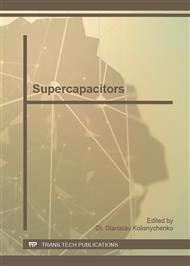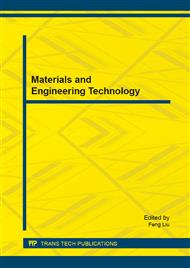[1]
C.H. Xu, B.H. Xu, Y. Gu, Z.G. Xiong, J. Sun, X.S. Zhao, Graphene-based electrodes for electrochemical energy storage, Energ. Environ. Sci. 6 (2013) 1388-1414.
DOI: 10.1039/c3ee23870a
Google Scholar
[2]
D.S. Yu, L.M. Dai, Self-assembled graphene/carbon nanotube hybrid films for supercapacitors, J. Phys. Chem. Lett. 1 (2010) 467-470.
DOI: 10.1021/jz9003137
Google Scholar
[3]
K.S. Novoselov, A.K. Geim, S.V. Morozov, D. Jiang, Y. Zhang, S.V. Dubonos, I.V. Grigorieva, A.A. Firsov, Electric field effect in atomically thin carbon films, Science 306 (2004) 666-669.
DOI: 10.1126/science.1102896
Google Scholar
[4]
Y. Wang, Z.Q. Shi, Y. Huang, Y.F. Ma, C.Y. Wang, M.M. Chen, Y.S. Chen, Supercapacitor devices based on graphene materials, J. Phys. Chem. C 113 (2009) 13103-13107.
DOI: 10.1021/jp902214f
Google Scholar
[5]
Y.W. Zhu, S. Murali, M.D. Stoller, K.J. Ganesh, W.W. Cai, P.J. Ferreira, A. Pirkle, R.M. Wallace, K.A. Cychosz, M. Thommes, D. Su, E.A. Stach, R.S. Ruoff, Carbon-based supercapacitors produced by activation of graphene, Science 332 (2011).
DOI: 10.1126/science.1200770
Google Scholar
[6]
L.L. Zhang, X. Zhao, M.D. Stoller Y.W. Zhu, H.X. Ji, S. Murali, Y.P. Wu, S. Perales, B. Clevenger, R.S. Ruoff, Highly conductive and porous activated reduced graphene oxide films for high-power supercapacitors, Nano Lett. 12 (2012) 1806-1812.
DOI: 10.1021/nl203903z
Google Scholar
[7]
G. Q Ning, Z.J. Fan, G. Wang, J.S. Gao, W.Z. Qian, F. Wei, Gram-scale synthesis of nanomesh graphene with high surface area and its application in supercapacitor electrodes, Chem. Commun. 47 (2011) 5976-5978.
DOI: 10.1039/c1cc11159k
Google Scholar
[8]
Y.C. Bai, R.B. Rakhi, W. Chen, H.N. Alshareef, Effect of pH-induced chemical modification of hydrothermally reduced graphene oxide on supercapacitor performance, J. Power Sources 233 (2013) 313-319.
DOI: 10.1016/j.jpowsour.2013.01.122
Google Scholar
[9]
S.D. Perera, R.G. Mariano, N. Nijem, Y. Chabal, J.P. Ferraris, K.J. Balkus, Alkaline deoxygenated graphene oxide for supercapacitor applications: An effective green alternative for chemically reduced graphene, J. Power Sources 215 (2012) 1-10.
DOI: 10.1016/j.jpowsour.2012.04.059
Google Scholar




